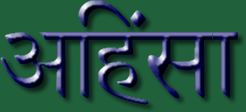

Internet Explorer users should note that, because Internet Explorer is not fully CSS2 compliant (despite Microsoft's claims), you will be unable to view this site as it is intended. I have made every effort to make this site useable by IE but if you should fine any problems with it, please email me.



Ahimsa, non-violence or do no harm, is the first of the yamas identified by Patañjali in his Yoga Sutras:
2.29 The eight limbs of Union are self-restraint in actions, fixed observance, posture, regulation of energy, mind-control in sense engagements, concentration, meditation, and realization.
2.30 Self-restraint in actions includes abstention from violence, from falsehoods, from stealing, from sexual engagements, and from acceptance of gifts.
2.31 These five willing abstentions are not limited by rank, place, time or circumstance and constitute the Great Vow.Yoga Sutras of Patañjali, 2:29-31
Patañjali touches on each of the yamas and says this of ahimsa:
2.35 When one is confirmed in non-violence, hostility ceases in his presence.
Yoga Sutras of Patañjali, 2:35
It is significant that in his instructions on Yoga that Patañjali wrote about ahimsa before any other part of the eight limbs. This indicates that ahimsa underlies every other aspect and that it is the principle that grounds all of a yogi's actions. Patañjali says that when we are non-violent, the potential violence around us comes to an end.
As stated elsewhere, the yamas govern how one interacts with the surrounding world beginning with one's own body and moving outward from there. Forgetting the body when practicing ahimsa can be a painful experience. A good example is janu sirsasana. If one uses a strap around the foot, it is very easy to pull on the strap vigorously and so injure the lower back; this comes, unfortunately, from first hand experience. That day I learned a very poignant and painful lesson: Do no harm applies first and foremost to what I do to myself.
For many, ahimsa means doing no harm of any kind under any circumstances and as such many yogis are vegetarian or vegan. This is understandable from a certain point of view, especially if one believes in reincarnation. Is doing harm acceptable under certain circumstances? Normally cutting a person's arm off would be prohibited by ahimsa but what if cutting the arm off is the only way to save that person's life? It is important to remember that not all circumstances are equal. My own belief does not encompass reincarnation and is that God has placed all life, animals and plants, under the stewardship of man and that all life has been placed here for our use, including using meat for food. That stewardship requires that I use these things wisely and with gratitude. I am grateful for each life, plant or animal, which makes my life possible whether it be the trees which were felled to build my home or the vegetables and fish which will make my meal tonight.
I would encourage each to examine his own heart. Does it say that ahimsa requires a vegan lifestyle? If so, be vegan but remember that forcing one's view upon another is a sure sign of one who had not achieved ahimsa.
Namasté